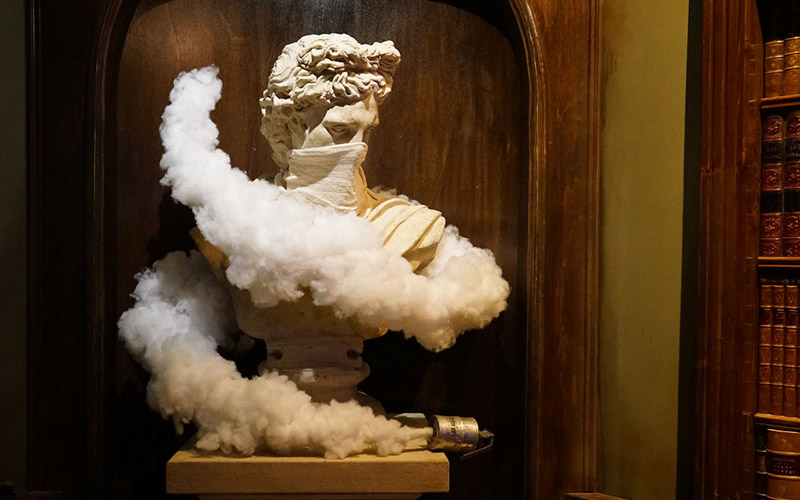

The bust of Apollo is an artwork from the Walled Off Hotel in Bethlehem which opened in 2017. Banksy’s work in the West Bank is always closely linked to a critique of the military oppression that prevails onsite. In this case, we see another adaptation of a neoclassical sculpture, a cloth covering its mouth and nose, standing in the rising smoke of a smoke grenade. The bust is based on the statue of Apollo of Belvedere, one of the most admired and described ancient sculptural works of Rome. For Winckelmann, who repeatedly describes the Apollo statue, the image fulfils “the highest ideal of art among all works of antiquity”. Together with the bust of Artemis of Versailles, attributed to Leochares, the Apollo forms a popular pair of busts. In Greek and Roman mythology, Apollo is the god of light, healing, spring, moral purity and moderation, as well as divination, music and the arts. As the protector of these, Apollo presided over the nine Muses and was also a god of atonement.
Die Büste des Apollo ist ein Kunstwerk aus dem „Walled Off Hotel“ in Bethlehem, welches 2017 eröffnete. Banksys Arbeiten im Westjordanland sind immer eng verbunden mit Kritik an der militärischen Unterdrückung, die vor Ort herrscht. In diesem Fall sehen wir eine weitere Adaption einer klassizistischen Skulptur, die mit einem Mund und Nase bedeckenden Tuch im aufsteigenden Rauch einer Nebelgranate steht. Der Büstenausschnitt leitet sich von der Statue des Apollo von Belvedere her, eines der am meisten bewunderten und beschriebenen antiken bildhauerischen Werke Roms. Gemeinsam mit der Büste der Artemis von Versailles, die Leochares zugeschrieben wurde, bildet der Apollo ein beliebtes Büstenpaar. Apollo ist in der griechischen und römischen Mythologie der Gott des Lichts, der Heilung, des Frühlings, der sittlichen Reinheit und Mäßigung sowie der Weissagung, der Musik und Künste. Als Beschützer dieser stand Apollo den neun Musen vor und war zugleich ein Sühnegott.
Apollon-bysten er et verk fra The Walled Off Hotel i Betlehem, som ble åpnet i 2017. Banksys arbeider på Vestbredden er alltid knyttet til kritikk av den militære undertrykkelsen som råder der. I dette tilfellet ser vi enda en tilpasning av en neoklassisk skulptur, der et tøystykke dekker nesen og munnen, og røyk stiger fra en røykgranat. Bysten er basert på statuen Apollo di Belvedere, en av de mest beundrede og beskrevne av de antikke romerske skulpturene. For Winckelmann, som gjentatte ganger beskriver Apollon-statuen, oppfyller verket det høyeste kunstidealet av alle antikke verk. Sammen med Artemis-statuen i Versailles, som blir tilskrevet Leochares, danner Apollon-bysten et populært sett med byster. I gresk og romersk mytologi er Apollon guden for lys, helbredelse, vår, moralsk renhet, måtehold, musikk og kunst. Som beskytter av disse verdiene ledet Apollon de ni musene og var også tilgivelsens gud.
Popiersie Apolla jest dziełem sztuki z hotelu Walled Off w Betlejem, który został otwarty w 2017 roku. Prace Banksy’ego na Zachodnim Brzegu są zawsze ściśle związane z krytyką militarnego ucisku, który tam panuje. W tym przypadku widzimy kolejną adaptację neoklasycznej rzeźby stojącej w unoszącym się dymie granatu dymnego, której usta i nos zakrywa tkanina. Popiersie oparte jest na posągu „Apolla z Belwederu”, jednym z najbardziej podziwianych i opisanych starożytnych dzieł rzeźbiarskich Rzymu. Dla Winckelmanna, który regularnie opisuje posąg Apolla, obraz ten spełnia „najwyższy ideał sztuki wśród wszystkich dzieł starożytności”. Wraz z „Popiersiem Artemidy” z Wersalu, przypisywanym Leocharesowi, Apollo tworzy popularną parę popiersi. W mitologii greckiej i rzymskiej Apollo jest bogiem światła, uzdrawiania, wiosny, czystości moralnej i umiaru, a także wróżbiarstwa, muzyki i sztuki. Jako ich obrońca, Apollo przewodniczył dziewięciu muzom i był także bogiem pokuty.
